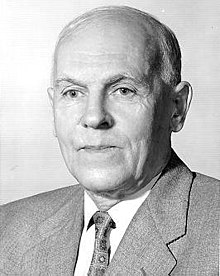Alexander Hrennikoff
Alexander Hrennikoff , Russian Александр Павлович Хренников , transcription Alexander Pawlowitsch Khrennikow, also transcribed in English by Aleksandr Pavlovich Khrennikov, (born November 11, 1896 in Moscow ; † December 31, 1984 in Vancouver ) was a co-founder of the grid construction method in Vancouver .
Hrennikoffs studied at the Moscow Institute for Communication Engineers and emigrated to Canada in 1933, where he received his master's degree from the University of British Columbia . In 1940 he received his PhD from the Massachusetts Institute of Technology . In his dissertation ( Plane stress and bending of plates by method of articulated framework ) and the subsequent publications based on it, he developed the grating method . Two-dimensional elastic continua are approximated by trusses. Hrennikoff later expanded the method and applied it, among other things, to the stability analysis of dishes and plates. It was the first method used in the early phase of the use of computers for design and calculation in the automotive industry and a forerunner of the finite element method. He was professor of civil engineering at the University of British Columbia from 1941 to 1984.
In 1949 he received the Moisseiff Award from ASCE .
Important publications
- A. Hrennikoff: Solution of problems of elasticity by the frame-work method . ASME J. Appl. Mech. 8 (1941), 8, pp. 169-175
- Flegel, Robert: Contributions to the Hrennikoff's rod models for disk and plate problems . 1968
Web links
Individual evidence
- ^ Karl-Eugen Kurrer : Hrennikoff, Aleksander Pavlovich . In: History of structural engineering. In search of balance . Ernst & Sohn , Berlin 2016, ISBN 978-3-433-03134-6 , pp. 843 u. P. 986 .
| personal data | |
|---|---|
| SURNAME | Hrennikoff, Alexander |
| ALTERNATIVE NAMES | Хренников, Александр (Russian); Khrennikov, Alexander; Chrennikow, Alexander Pavlovich |
| BRIEF DESCRIPTION | Russian-Canadian civil engineer |
| DATE OF BIRTH | November 11, 1896 |
| PLACE OF BIRTH | Moscow |
| DATE OF DEATH | December 31, 1984 |
| Place of death | Vancouver |
